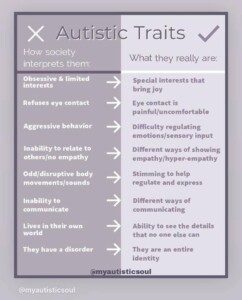Some autism checklists can make an undiagnosed Autistic think they can’t possibly be on the spectrum, and they end up never getting assessed.
Here’s what to look out for.
You’re beginning to suspect that you just might have a mild form of Autism Spectrum Disorder.
You do some searching on ASD and come across an infographic such as the one below.

You then think, “No, that’s not me; I can’t possibly be autistic.”
You then continue on with your life, wondering why you’re the way you are; wondering why everyone else seems almost like a different species.
You just don’t get people. They don’t get you, either. You relish solitude and your prized interests, and can’t understand how people could waste time “partying.” You hate when your routine is broken…
You then again begin wondering if maybe, after all, you really are autistic.
You come across another list of autism traits, and it’s similar to the one above. Nope, I’m not autistic.
These stereotypical lists of autism traits are misleading and can steer people away from seeking an ASD assessment — people who’d actually get a diagnosis of autism from a seasoned practitioner who specializes in ASD assessments.
Thanks to stereotypical autism trait checklists, many adults are getting very late diagnoses.
Though the traits in the above infographic are very common in ASD, there are also Autists who have only a few of them.
Obsessions and Limited Interests

©Lorra Garrick
This resonates with up to 95% of people on the Spectrum. But an undiagnosed, wondering individual may not even realize they have obsessions or hyperfixations.
For example, I had a strong hyperfixation on the issue of holding onto a treadmill. It’s wrong!
I’d refer to this as a “pet peeve,” an extension of my lifelong passion for physical fitness.
I eventually became a certified personal trainer and have written extensively on fitness, exercise and workouts.
I had thought it was only natural that I develop an intense “pet peeve” on some aspect of working out: the treadmill.
After researching autism during my diagnostic journey, I realized, “Damn, this whole treadmill thing was a special interest!”
Special interests is a term of endearment for the Autistic’s obsessions or hyperfixations.
As you can see with the treadmill example, hyperfixations can masquerade as normal thought processes.
However, it hadn’t taken me long to realize that all my life, I’d had hyperfixations or very peculiar interests — that I had attributed to simply being fascinated by the world around me.
But then there was that eye contact thing.
Refuses Eye Contact

©Lorra Garrick
I kept worrying that I wasn’t autistic because eye contact was never “painful” or “uncomfortable.”
I wanted to get the ASD diagnosis because it was the only thing that could possibly explain why I was the way I was. It’d be so validating and emancipating. It’d be so … COOL!
Don’t let the stereotypical refusal to make eye contact steer you away from an ASD assessment.
Trust me when I say this: I took a deep dive on this topic, reading everything I could find on it online – and here are my conclusions:
• There’s very little research on eye contact in autism.
• The best information about this is in autism online communities.
• I’ve hit up all the threads on eye contact in the two biggest autism online communities, plus on Quora.
• Eye contact in autism is a bell curve.
• On one side are those who experience no difficulties. On the other are those who find it unbearable for even a second. Everyone else falls somewhere in between.
• The vast majority of autistic people I’ve spoken to have given me what appears to be direct eye contact.
This doesn’t mean it’s not uncomfortable for some of them, but it also means they’re not refusing it, either. Some look between the eyes or at the forehead, while others have told me it’s direct.
Aggressive Behavior

Freepik.com/katemangostar
This is ambiguous. Plenty of neurotypicals (NTs) behave aggressively, such as during road rage incidents and at bars, nightclubs, parties, family get-togethers and the workplace.
Nevertheless, when reading about “aggressive behavior” in autism, many people will picture someone yelling, pushing a chair, kicking a wall and throwing things – all in response to discovering that the meeting they were preparing for at work has been cancelled.
When we see the word “aggressive,” we think of someone acting out at another person.
Most autistic individuals do not aggress themselves on others, though most are prone to at least an occasional “meltdown” in the wake of sensory overload.
If you’re not an aggressive person, in the sense of hitting yourself or others, throwing chairs or punching at walls due to feeling overstimulated or having plans suddenly change on you – this does NOT mean you can rule out having autism!
Inability to Relate to Others/No Empathy

Shutterstock/Antonio Guillem
Actually, for anyone who’s beginning to suspect that they might be autistic, this is the one trait that will resonate with them big-time.
The inability to relate to others – or to understand people, “get” people or feel a connection with them – is the one trait that nearly every Autistic will identify with.
Some will say that they’re good at relating to people – after learning how and practicing and practicing … and practicing.
NTs relate to people instinctively and intuitively. Autistics often put on a show that’s not truly themselves, after rehearsing it. This is called masking.
Inside, they don’t feel a natural connection, while fooling NTs that they’re connecting.
But there are autistic individuals who’ve never been good at masking, so that NTs can easily pick up on their oddness, weirdness or quirkiness.
Odd Disruptive Body Movements and Sounds

You might think, “Oh, that’s definitely not me!” But … are you sure?
First off, what bothers me about this descriptor is the word “disruptive.” I stim all the time, and none of my stims are disruptive.
Just what is a disruptive stim, anyways? Is it a noisy one during class at school? Yes, that would seem so. But to list “disruptive” as part of a traits list is misleading.
Second, not all stims involve making noise.
Now, here’s the kicker: You may be a heavy stimmer and not even realize it!
I rock at home. Because I never did this around people, I never thought of it as an autistic stim.
If you do your obvious “movements” at home and suppress them in public, this makes you NO LESS autistic than an Autistic who dramatically and noisily stims in public around people.
You may also be making sounds that, all this time, you never thought were autistically driven.
I produce vocals that are related to stimming with my hair. If I did these in public, people would stare and think something was very wrong with me.
Stimming can be any of the following: tapping one’s face, pulling at one’s skin, any “odd” movements with the fingers or hands, chewing one’s cuticles, sucking on knuckles, clicking the teeth, chewing the tongue, flapping the hands, curling the toes, flexing the calves, bouncing a leg, flapping a foot, vocal noises, sniffing or chewing one’s hair, feeling a certain texture such as velvet, tearing or crumpling paper, shaking tinfoil, chewing on pens, staring at spinning objects, spinning, toe walking – the sky’s the limit.
A tipoff that you stim is that of any repetitive action that you’d never do around people.
Inability to Communicate

This burns me up; it’s so stereotypical, painting the picture that autism necessarily means impairment in communication.
There are autistic people who are supervisors on the job or are in positions of training employees.
There are Autistics who are teachers, college professors, retail workers, nurses, motivational speakers, police officers, lawyers, social workers, mental health counselors or therapists, and even psychologists who administer autism assessments.
Though some autistic people are nonspeaking and rely on devices to communicate – and some will actually never learn how to communicate at all – there are others who are highly fluent in verbal communication and explaining complex topics.
Lives in Their Own World

This is another trait that nearly every Autistic will easily relate to. Oh yes, we sure do live in our own world!
While some Autistics seem to be in their own world nearly every waking moment (those with very substantial support needs or Level 3 autism), others can pop in and out of their rich inner worlds at will.
You’ll also be interested in this article: Can You Be Autistic if You Have Good Eye Contact?
 Lorra Garrick has been covering medical and fitness topics for many years, having written thousands of articles for print magazines and websites, including as a ghostwriter. She’s also a former ACE-certified personal trainer. In 2022 she received a diagnosis of Level 1 Autism Spectrum Disorder.
Lorra Garrick has been covering medical and fitness topics for many years, having written thousands of articles for print magazines and websites, including as a ghostwriter. She’s also a former ACE-certified personal trainer. In 2022 she received a diagnosis of Level 1 Autism Spectrum Disorder.
.



























